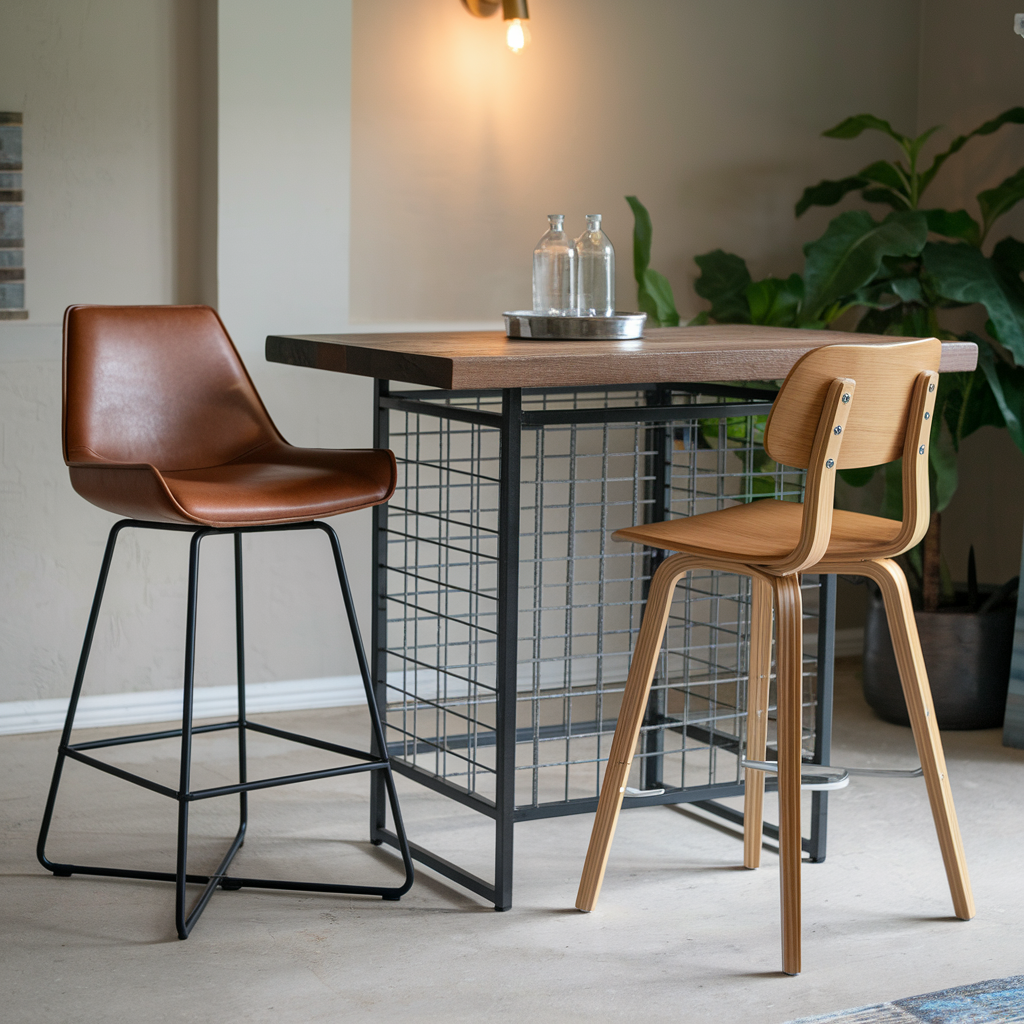Bar Tables Inspiration & Tips
A Complete Guide To Choosing the Right Bar Table for Dining And Entertaining
Bar table heights and seating: getting the ergonomics right
Bar tables generally come in two height families: counter height and bar (pub) height. Matching your table to the correct stool height ensures comfortable posture and easy leg clearance.
| Type | Typical Table Height | Matching Seat Height | Best For |
|---|---|---|---|
| Counter-Height Bar Table | 34–36 in (86–91 cm) | 24–26 in (61–66 cm) | Kitchen islands, informal dining, multipurpose spaces |
| Bar/Pub-Height Table | 40–42 in (102–107 cm) | 28–30 in (71–76 cm) | Home bars, entertainment nooks, compact social corners |
Choosing the right size for your room and guests
The ideal bar table size balances seating capacity with circulation. Measure your room and map traffic paths to avoid crowding during gatherings.
Clearances and pathways
- Leave at least 36 in (91 cm) between the table edge and walls or large furniture for easy movement.
- Allow 24–26 in (61–66 cm) of width per seat to reduce elbow bumps.
- If stools swivel or have arms, increase spacing by ~2 in (5 cm).
Common footprints
Small spaces (2–3 people): Round top Ø 24–30 in (61–76 cm) or narrow rectangular top 24×30–36 in (61×76–91 cm). Ideal for studio apartments or kitchen corners.
Medium spaces (4 people): Round Ø 36–40 in (91–102 cm) or rectangular 24–30 × 48 in (61–76 × 122 cm). A versatile size for weeknight dining and weekend drinks.
Larger gatherings (5–6 people): Rectangular 30 × 60–72 in (76 × 152–183 cm) or oval/round Ø 44–48 in (112–122 cm), if your room can support the clearances above.
Shapes and edges: flow, sightlines, and comfort
The shape of a bar table affects how people interact and how the piece fits the architecture around it.
- Round: Promotes conversation and smooth circulation; great for square or compact rooms.
- Square: Balanced look for corner placements; best when you have equal wall clearances.
- Rectangular: Efficient for narrow rooms and along walls; consider rounded corners for safer traffic flow.
- Oval: Softer edges with rectangular seating capacity; helpful where door swings and walkways are close.
Materials and finishes: durability and maintenance
Different materials support different lifestyles. Consider heat resistance, scratch resilience, and cleaning routines before choosing a finish.
Solid wood and veneers
Solid wood brings natural grain and warmth that pairs easily with sideboards and adjacent storage. Durable species like oak, ash, or walnut hold up well to daily use. Veneers on stable cores offer a refined look with consistent surfaces. Clean with a slightly damp cloth and dry promptly.
Stone and ceramic
Engineered stone and sintered surfaces resist heat and stains better than many natural stones. They complement modern appliances and metallic fixtures in open kitchens.
Metal and glass
Powder-coated steel bases add stability and a slim profile, while tempered glass tops keep sightlines open in smaller rooms. Fingerprints are more visible on gloss glass; microfiber cloths help maintain clarity.
Bases and stability: what to look for
A stable base is essential, especially at bar height. Options include four-leg frames, trestles, sled bases, and weighted pedestals.
- Pedestal bases free legroom and simplify stool placement; choose a weighted design for taller tables.
- Trestle and sled bases offer visual structure and lateral stability; mind foot placement and footrest height.
- Adjustable feet help level the table on hard floors and protect surfaces.
Coordinating stools, storage, and dining pieces
For a cohesive space, coordinate your bar table with seating, dining tables, and storage finishes. Start with stools that match the table height and frame color. For formal dining nearby, consider a complementary piece from our Dining Tables collection. For serveware and linens, a streamlined unit from Buffets & Sideboards can anchor the wall and add storage. Planning a complete bar setup? Compare seat backs, arm options, and footrests in Bar Stools, then select the surface and base that fit your hosting style in Bar Tables. For more layout tips, browse our blog categories.
Layout examples for real spaces
Studio apartment with one wall kitchen
Choose a 24–30 in wide rectangular counter-height bar table placed parallel to the kitchen run. Pair with backless counter stools that tuck fully under the top to preserve walking space.
Open-plan family room
Select an oval or round 40–44 in top at counter height to keep views open to the living area. Use medium-back stools for support and easy conversation with people on the sofa.
Dedicated entertaining corner
Opt for a 40–42 in bar-height pedestal table with swivel stools. Add a narrow sideboard for glasses and bar tools; see options in Buffets & Sideboards.
Care and maintenance checklist
- Use coasters and placemats to minimize water rings and heat marks.
- Wipe spills promptly with a soft cloth; avoid harsh abrasives and oversaturated cleaning.
- Retighten hardware every few months, especially on taller bar tables that see frequent movement.
- Place felt pads under bases; for heavy tables, use glides designed for your floor type.
Frequently asked questions
How many stools fit at my bar table?
Plan for 24–26 in of width per seat. A 48 in long table works best with two stools; 60–72 in can seat three or four, depending on stool arms and swivel.
Counter height or bar height—how do I choose?
If your table will double as prep or everyday dining near standard counters, counter height (34–36 in) blends seamlessly. For a social, stand-and-sip vibe, choose bar height (40–42 in).
Which stools pair with my table?
Match seat height to table height (10–12 in clearance). Explore curated options in Bar Stools. For mixed-use rooms, consider stools with backs for support during longer meals.
Next steps
Measure your space, decide on height, select a size that preserves walkways, then choose a shape and material that suit your daily use. When you are ready to build a coordinated set, browse Bar Tables alongside Bar Stools, and complement the setting with storage from Buffets & Sideboards. For deeper planning advice, see related articles in our blog and explore complete dining solutions in Dining Tables. Return to the homepage to continue your search.

